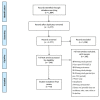Systematic review on the impact of the pneumococcal conjugate vaccine ten valent (PCV10) or thirteen valent (PCV13) on all-cause, radiologically confirmed and severe pneumonia hospitalisation rates and pneumonia mortality in children 0-9 years old
- PMID: 36734192
- PMCID: PMC9896304
- DOI: 10.7189/jogh.13.05002
Systematic review on the impact of the pneumococcal conjugate vaccine ten valent (PCV10) or thirteen valent (PCV13) on all-cause, radiologically confirmed and severe pneumonia hospitalisation rates and pneumonia mortality in children 0-9 years old
Abstract
Background: There is an ongoing need to assess the impact of pneumococcal conjugate vaccines (PCVs) to guide the use of these potentially valuable but under-utilized vaccines against pneumonia, which is one of the most common causes of post-neonatal mortality.
Methods: We conducted a systematic review of the literature on PCV10 and PCV13 impact on all-cause, radiologically confirmed and severe pneumonia hospitalisation rates as well as all-cause and pneumonia-specific mortality rates. We included studies that were published from 2003 onwards, had a post-licensure observational study design, and reported on any of our defined outcomes in children aged between 0-9 years. We derived incidence rates (IRs), incidence rate ratios (IRRs) or percent differences (%). We assessed all studies for risk of bias using the Effective Public Health Practice Project (EPHPP) quality assessment tool.
Results: We identified a total of 1885 studies and included 43 comparing one or more of the following hospitalised outcomes of interest: all-cause pneumonia (n = 27), severe pneumonia (n = 6), all-cause empyema (n = 8), radiologically confirmed pneumonia (n = 8), pneumococcal pneumonia (n = 7), and pneumonia mortality (n = 10). No studies evaluated all-cause mortality. Studies were conducted in all WHO regions except South East Asia Region (SEAR) and low- or middle-income countries (LMICs) in the Western Pacific Region (WPR). Among children <5 years old, PCV impact ranged from 7% to 60% for all-cause pneumonia hospitalisation, 8% to 90% for severe pneumonia hospitalisation, 12% to 79% for radiologically confirmed pneumonia, and 45% to 85% for pneumococcal confirmed pneumonia. For pneumonia-related mortality, impact was found in three studies and ranged from 10% to 78%. No obvious differences were found in vaccine impact between PCV10 and PCV13. One study found a 17% reduction in all-cause pneumonia among children aged 5-9 years, while another found a reduction of 81% among those aged 5-17 years. A third study found a 57% reduction in all-cause empyema among children 5-14 years of age.
Conclusion: We found clear evidence of declines in hospitalisation rates due to all-cause, severe, radiologically confirmed, and bacteraemic pneumococcal pneumonia in children aged <5 years, supporting ongoing use of PCV10 and PCV13. However, there were few studies from countries with the highest <5-year mortality and no studies from SEAR and LMICs in the WPR. Standardising methods of future PCV impact studies is recommended.
Copyright © 2023 by the Journal of Global Health. All rights reserved.
Conflict of interest statement
Disclosure of interests: The authors completed the ICMJE Disclosure of Interest Form (available upon request from the corresponding author) and disclose no relevant interests.
References
-
- Perin J, Mulick A, Yeung D, Villavicencio F, Lopez G, Strong KL, et al. Global, regional, and national causes of under-5 mortality in 2000-19: an updated systematic analysis with implications for the Sustainable Development Goals. Lancet Child Adolesc Health. 2022;6:106-15 10.1016/S2352-4642(21)00311-4 - DOI - PMC - PubMed
-
- WHO. Pneumococcal conjugate 3rd dose (PCV3) immunization coverage. Available: https://www.who.int/gho/immunization/pneumococcal/en/. Accessed: 15 January 2023.
-
- WHO Pneumococcal conjugate vaccines in infants and children under 5 years of age: WHO position paper – February 2019. Wkly Epidemiol Rec. 2019;8:85-104.
-
- USCDC. Global Pneumococcal Disease and Vaccine. 2022. Available: https://www.cdc.gov/pneumococcal/global.html. Accessed: 15 January 2023.
Publication types
MeSH terms
Substances
LinkOut - more resources
Full Text Sources
Medical

